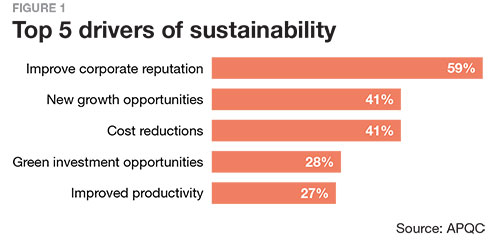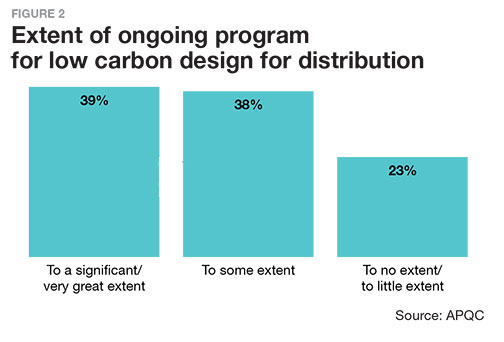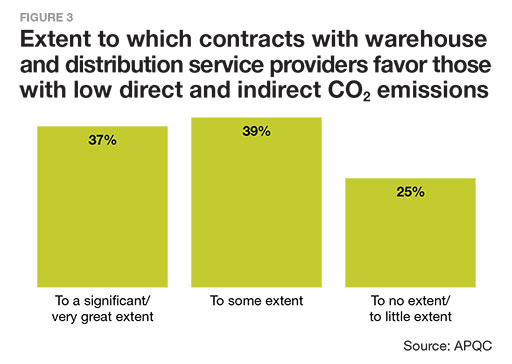Sorry, but your login has failed. Please recheck your login information and resubmit. If your subscription has expired, renew here.
November 2021
This is the last regular issue of Supply Chain Management Review for 2021. Normally this time of year, I look forward to what’s in front of us. That’s turned out to be a fool’s errand over the last year and a half. So, instead, I looked back to see what I wrote this time last year. My column was titled “COVID hasn’t stopped supply chain progress.” Browse this issue archive.Need Help? Contact customer service 847-559-7581 More options
Sustainability is a concept that will continue to have an impact on organizations far into the future. Customer expectations, regulatory demands and environmental changes are increasing the pressure for organizations to take meaningful action. With no clear path forward, many leaders are unsure how best to take action.
Yet organizations often do have what they need to address the challenge of sustainability. APQC has found that organizations can achieve success by developing a strategy, focusing on processes, defining responsibilities and identifying necessary tools and approaches.
Understanding sustainability
The first step in addressing sustainability is to understand what it means. Unfortunately, this is difficult due to the number of buzzwords, jargon, frameworks and models used to describe sustainability. APQC has developed a simple, holistic and actionable definition of sustainability.
Sustainability is simply the capacity to endure. The primary components of sustainability include:
- environmental practices that protect natural resources needed by future generations;
- people practices that ensure workers within the organization are kept safe and treated equitably;
- social practices that promote community development and human rights for people beyond the organization; and
- governance, management and financial practices that promote ethical operations and long-term organizational health.
Sustainability is about more than preventing environmental harm. Organizations must also focus on taking care of people and communities, as well as ensuring their long-term health.

Sustainability is a must
Interest in sustainability has steadily increased year over year, but in the past few years it has shifted from a “nice-to-have” to a “must-have.” APQC’s Process and Performance Management Priorities and Challenges research found that 60% of organizations have sustainability as part of their strategic plans for 2021. As shown in Figure 1, the top drivers for sustainability vary widely, from a focus on growth opportunities, to green investment, to improved productivity.
Organizations report a variety of areas of focus for their sustainability efforts. Overall, these areas fall into three categories: environmental, social and governance, or ESG. In the environmental category, energy is the top area of focus. For the social category, the top area of focus is local communities. For governance, diversity and equal opportunity is the top
area of focus.
In supply chain, sustainability is a particularly hot topic because supply chain processes are often the biggest contributors to an organization’s overall carbon footprint. APQC’s 2021 Supply Chain Priorities and Challenges research identified sustainability as one of the top two trends expected to affect supply chains in the next three years.
Several factors have contributed to a heightened level of interest in sustainability in the supply chain. One is that the extreme weather events that climate change experts predicted started to become a reality. When the COVID-19 pandemic hit and consumers took more of their shopping online, many began to seek out information about companies’ environmental and social practices before purchasing new products. At the same time, a series of supply shocks highlighted the complexity and fragility of organizations’ supply chains. In 2020 and 2021, leaders struggled to balance long-term goals for sustainability with the short-term need to get products out to customers.
The focus on sustainability stems not just from how important it is, but also how hard it is (or how hard it appears to be). Leaders want their organizations to be more sustainable, but amid supply issues, cost pressures and other fast-changing circumstances, they are often unsure how to pursue sustainability goals while keeping their organizations afloat.
Sustainability and supply chain
In 2020, shortages in key consumer products introduced average citizens to the term “supply chain.” In 2021, many shortages from the previous year have continued (e.g., computer chips), and others have emerged (e.g., lumber).
Sustainability is about much more than the actions taken by just one company. An organization’s suppliers—and its suppliers’ suppliers—are key to its ability to achieve sustainability goals. Consumers cared about corporate sustainability and social responsibility before, but now they are much more aware of how supply chains affect these factors.
Distribution network design provides a valuable opportunity to improve sustainability, while trimming costs and achieving faster shipments. Ideally, organizations should create a holistic program that assesses location optimization, estimates life-cycle energy savings, coordinates source and demand points and accounts for reverse logistics.
As shown in Figure 2, less than 40% of organizations have adopted a program for low carbon distribution network design to a very great extent. Nearly one-quarter have done so to no extent or to only a little extent.

When it comes to these types of distribution networks, some industries are slightly ahead, such as the petroleum/chemical industry. Forty-three percent of these organizations have adopted these networks to a significant or very great extent. Other industries are lagging, such as retail and wholesale, with only 24% of organizations having developed these networks to a significant or very great extent. For some industries, such as petroleum, environmental impact is already top of mind for consumers and regulators, which can lead to broader adoption of carbon reduction efforts. APQC recommends that organizations consider integrating carbon reduction programs into the overall distribution strategy to expedite implementation. Programs can also align carbon reduction goals with broader business goals related to costs
and efficiency.
Many of the world’s largest and most influential companies have set forth bold plans to make their supply chains more sustainable. For example, consumer goods company Unilever and food corporation Cargill have both promised to make their supply chains deforestation-free. Several large companies have committed to reach net-zero carbon emissions, which will require a solid partnership with suppliers. Consumers will be watching closely to see whether organizations follow up their promises.
Organizations would be wise to favor low-emissions warehouse and distribution service providers to minimize their overall impact on the environment. However, as shown in Figure 3, only 37% of organizations across industries focus on securing contracts with low-emissions providers to a significant or very great extent.
In this area, the petroleum/chemical industry is again slightly ahead of the cross-industry results, with 41% adopting the practice to a significant or very great extent. The retail and wholesale industry is again behind, with only 29% of these organizations adopting the practice to a significant or very great extent.

Consumers’ demand for more sustainable supply chains is translating into political action as governments introduce new regulations and enforcement processes targeting environmental, people and social impact. For example, U.S. Customs and Border Protection has ramped up enforcement of import restrictions on companies whose supply chains incorporate child and forced labor.
Taking action
To tackle sustainability, organizations should consider it another business challenge. The approach should be the same as for other challenges: define the strategy, execute the process, define roles and responsibilities and select tools and approaches.
APQC recommends organizations take the following steps to develop and deploy a supply chain sustainability strategy.
- Document the organization’s definition of sustainability and its high-level sustainability strategy.
- Define ownership for sustainability within the organization. For example, will sustainability be owned at the global level, or regionally? Will supply chain have a seat on an enterprise-level governing body? Will it be owned at the level of supply chain or by those who own parts of the supply chain such as planning, sourcing, procurement or logistics?
- Deploy and strengthen processes to ensure transparency with suppliers, monitor global disruptions, prevent behaviors that introduce risk (e.g., maverick purchasing) and provide employees with the knowledge they need to make sustainable decisions.
- Assess sustainability factors within supply chain processes. For example:
- within supply chain planning, consider how network design can be optimized for sustainability;
- within sourcing and procurement, evaluate supplier diversity and supplier risk/sustainability;
- within logistics and warehousing, examine carbon emissions, fuel and routing; and
- within manufacturing, evaluate carbon emissions, water and electricity usage.
Take a process-first approach
Each organization’s sustainability challenges are different; therefore, each will have different goals and different approaches to reach those goals. Some need a complete overhaul of their environmental, people, social and governance practices. However, organization leaders should remember that sustainability goals need not conflict with budgetary and customer service priorities, especially when those priorities are established with a long-term viewpoint.
Any organization that has experience applying a process-first approach to other business challenges will be at an advantage when it comes to meeting the challenge of sustainability. A focus on processes and embedding measures within those processes enables organizations to show how they are working toward their commitments. With this approach they can 1) pinpoint the right inputs, outputs and choice points; 2) empower employees to make sustainable decisions and informed trade-offs; and 3) collect metrics to know what worked and what did not. Updates to processes in the high-impact area of supply chain and logistics in particular, can create repeatable, consistent improvement with regard to sustainability.
About APQC
APQC helps organizations work smarter, faster and with greater confidence. It is the world’s foremost authority in benchmarking, best practices, process and performance improvement, and knowledge management. APQC’s unique structure as a member-based nonprofit makes it a differentiator in the marketplace. APQC partners with more than 500 member organizations worldwide in all industries. With more than 40 years of experience, APQC remains the world’s leader in transforming organizations. Visit us at apqc.org and learn how you can make best
practices your practices.
SC
MR
Sorry, but your login has failed. Please recheck your login information and resubmit. If your subscription has expired, renew here.
November 2021
This is the last regular issue of Supply Chain Management Review for 2021. Normally this time of year, I look forward to what’s in front of us. That’s turned out to be a fool’s errand over the last year and a… Browse this issue archive. Access your online digital edition. Download a PDF file of the November 2021 issue.Sustainability is a concept that will continue to have an impact on organizations far into the future. Customer expectations, regulatory demands and environmental changes are increasing the pressure for organizations to take meaningful action. With no clear path forward, many leaders are unsure how best to take action.
Yet organizations often do have what they need to address the challenge of sustainability. APQC has found that organizations can achieve success by developing a strategy, focusing on processes, defining responsibilities and identifying necessary tools and approaches.
Understanding sustainability
The first step in addressing sustainability is to understand what it means. Unfortunately, this is difficult due to the number of buzzwords, jargon, frameworks and models used to describe sustainability. APQC has developed a simple, holistic and actionable definition of sustainability.
Sustainability is simply the capacity to endure. The primary components of sustainability include:
- environmental practices that protect natural resources needed by future generations;
- people practices that ensure workers within the organization are kept safe and treated equitably;
- social practices that promote community development and human rights for people beyond the organization; and
- governance, management and financial practices that promote ethical operations and long-term organizational health.
Sustainability is about more than preventing environmental harm. Organizations must also focus on taking care of people and communities, as well as ensuring their long-term health.

Sustainability is a must
Interest in sustainability has steadily increased year over year, but in the past few years it has shifted from a “nice-to-have” to a “must-have.” APQC’s Process and Performance Management Priorities and Challenges research found that 60% of organizations have sustainability as part of their strategic plans for 2021. As shown in Figure 1, the top drivers for sustainability vary widely, from a focus on growth opportunities, to green investment, to improved productivity.
Organizations report a variety of areas of focus for their sustainability efforts. Overall, these areas fall into three categories: environmental, social and governance, or ESG. In the environmental category, energy is the top area of focus. For the social category, the top area of focus is local communities. For governance, diversity and equal opportunity is the top
area of focus.
In supply chain, sustainability is a particularly hot topic because supply chain processes are often the biggest contributors to an organization’s overall carbon footprint. APQC’s 2021 Supply Chain Priorities and Challenges research identified sustainability as one of the top two trends expected to affect supply chains in the next three years.
Several factors have contributed to a heightened level of interest in sustainability in the supply chain. One is that the extreme weather events that climate change experts predicted started to become a reality. When the COVID-19 pandemic hit and consumers took more of their shopping online, many began to seek out information about companies’ environmental and social practices before purchasing new products. At the same time, a series of supply shocks highlighted the complexity and fragility of organizations’ supply chains. In 2020 and 2021, leaders struggled to balance long-term goals for sustainability with the short-term need to get products out to customers.
The focus on sustainability stems not just from how important it is, but also how hard it is (or how hard it appears to be). Leaders want their organizations to be more sustainable, but amid supply issues, cost pressures and other fast-changing circumstances, they are often unsure how to pursue sustainability goals while keeping their organizations afloat.
Sustainability and supply chain
In 2020, shortages in key consumer products introduced average citizens to the term “supply chain.” In 2021, many shortages from the previous year have continued (e.g., computer chips), and others have emerged (e.g., lumber).
Sustainability is about much more than the actions taken by just one company. An organization’s suppliers—and its suppliers’ suppliers—are key to its ability to achieve sustainability goals. Consumers cared about corporate sustainability and social responsibility before, but now they are much more aware of how supply chains affect these factors.
Distribution network design provides a valuable opportunity to improve sustainability, while trimming costs and achieving faster shipments. Ideally, organizations should create a holistic program that assesses location optimization, estimates life-cycle energy savings, coordinates source and demand points and accounts for reverse logistics.
As shown in Figure 2, less than 40% of organizations have adopted a program for low carbon distribution network design to a very great extent. Nearly one-quarter have done so to no extent or to only a little extent.

When it comes to these types of distribution networks, some industries are slightly ahead, such as the petroleum/chemical industry. Forty-three percent of these organizations have adopted these networks to a significant or very great extent. Other industries are lagging, such as retail and wholesale, with only 24% of organizations having developed these networks to a significant or very great extent. For some industries, such as petroleum, environmental impact is already top of mind for consumers and regulators, which can lead to broader adoption of carbon reduction efforts. APQC recommends that organizations consider integrating carbon reduction programs into the overall distribution strategy to expedite implementation. Programs can also align carbon reduction goals with broader business goals related to costs
and efficiency.
Many of the world’s largest and most influential companies have set forth bold plans to make their supply chains more sustainable. For example, consumer goods company Unilever and food corporation Cargill have both promised to make their supply chains deforestation-free. Several large companies have committed to reach net-zero carbon emissions, which will require a solid partnership with suppliers. Consumers will be watching closely to see whether organizations follow up their promises.
Organizations would be wise to favor low-emissions warehouse and distribution service providers to minimize their overall impact on the environment. However, as shown in Figure 3, only 37% of organizations across industries focus on securing contracts with low-emissions providers to a significant or very great extent.
In this area, the petroleum/chemical industry is again slightly ahead of the cross-industry results, with 41% adopting the practice to a significant or very great extent. The retail and wholesale industry is again behind, with only 29% of these organizations adopting the practice to a significant or very great extent.

Consumers’ demand for more sustainable supply chains is translating into political action as governments introduce new regulations and enforcement processes targeting environmental, people and social impact. For example, U.S. Customs and Border Protection has ramped up enforcement of import restrictions on companies whose supply chains incorporate child and forced labor.
Taking action
To tackle sustainability, organizations should consider it another business challenge. The approach should be the same as for other challenges: define the strategy, execute the process, define roles and responsibilities and select tools and approaches.
APQC recommends organizations take the following steps to develop and deploy a supply chain sustainability strategy.
- Document the organization’s definition of sustainability and its high-level sustainability strategy.
- Define ownership for sustainability within the organization. For example, will sustainability be owned at the global level, or regionally? Will supply chain have a seat on an enterprise-level governing body? Will it be owned at the level of supply chain or by those who own parts of the supply chain such as planning, sourcing, procurement or logistics?
- Deploy and strengthen processes to ensure transparency with suppliers, monitor global disruptions, prevent behaviors that introduce risk (e.g., maverick purchasing) and provide employees with the knowledge they need to make sustainable decisions.
- Assess sustainability factors within supply chain processes. For example:
- within supply chain planning, consider how network design can be optimized for sustainability;
- within sourcing and procurement, evaluate supplier diversity and supplier risk/sustainability;
- within logistics and warehousing, examine carbon emissions, fuel and routing; and
- within manufacturing, evaluate carbon emissions, water and electricity usage.
Take a process-first approach
Each organization’s sustainability challenges are different; therefore, each will have different goals and different approaches to reach those goals. Some need a complete overhaul of their environmental, people, social and governance practices. However, organization leaders should remember that sustainability goals need not conflict with budgetary and customer service priorities, especially when those priorities are established with a long-term viewpoint.
Any organization that has experience applying a process-first approach to other business challenges will be at an advantage when it comes to meeting the challenge of sustainability. A focus on processes and embedding measures within those processes enables organizations to show how they are working toward their commitments. With this approach they can 1) pinpoint the right inputs, outputs and choice points; 2) empower employees to make sustainable decisions and informed trade-offs; and 3) collect metrics to know what worked and what did not. Updates to processes in the high-impact area of supply chain and logistics in particular, can create repeatable, consistent improvement with regard to sustainability.
About APQC
APQC helps organizations work smarter, faster and with greater confidence. It is the world’s foremost authority in benchmarking, best practices, process and performance improvement, and knowledge management. APQC’s unique structure as a member-based nonprofit makes it a differentiator in the marketplace. APQC partners with more than 500 member organizations worldwide in all industries. With more than 40 years of experience, APQC remains the world’s leader in transforming organizations. Visit us at apqc.org and learn how you can make best
practices your practices.
SC
MR


Latest Supply Chain News
- Tech investments bring revenue increases, survey finds
- Survey reveals strategies for addressing supply chain, logistics labor shortages
- Israel, Ukraine aid package to increase pressure on aerospace and defense supply chains
- How CPG brands can deliver on supplier diversity promises
- How S&OP provides the answer to in-demand products
- More News
Latest Resources

 Explore
Explore
Business Management News
- Survey reveals strategies for addressing supply chain, logistics labor shortages
- How CPG brands can deliver on supplier diversity promises
- How S&OP provides the answer to in-demand products
- AI, virtual reality is bringing experiential learning into the modern age
- Tips for CIOs to overcome technology talent acquisition troubles
- There is still work to do to achieve supply chain stability
- More Business Management
Latest Business Management Resources

Subscribe

Supply Chain Management Review delivers the best industry content.

Editors’ Picks






